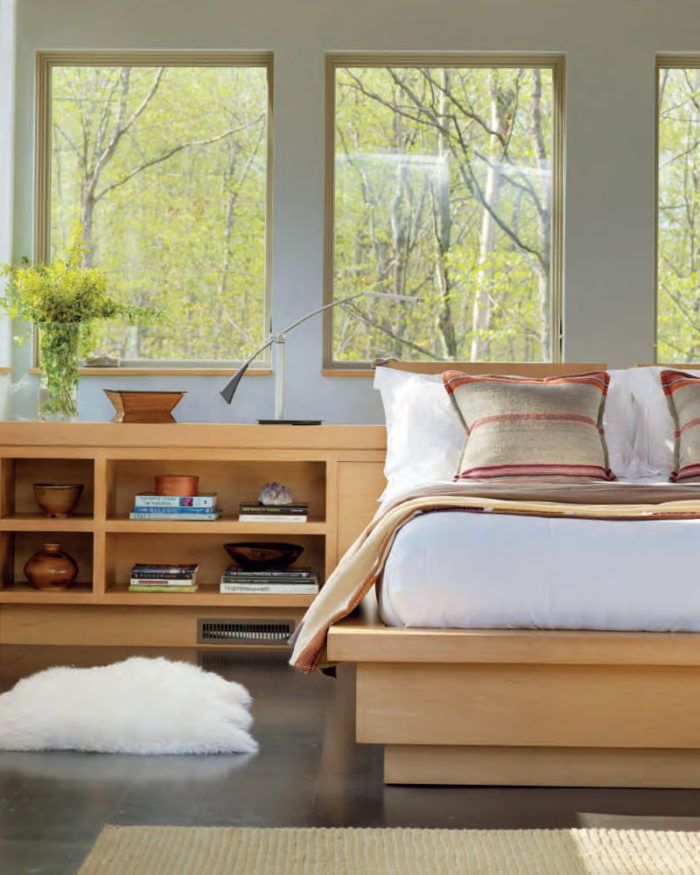FHB House: A Hardworking Spare Interior
6 types of specialized drywall in this home address demands for quieter spaces, durable surfaces, and better air quality.

Photo: Susan Teare, design by Mitra Designs, mitradesigns.com
When the framing and the installation of mechanical systems are complete in a new house and work turns to hanging drywall, it can seem as if there are acres of the paper-faced gypsum boards. This drywall is an essential finish in the crisp, clean, and minimalist interior planned for the FHB House. There is no crown molding, and instead of casing, the windows have simple drywall returns, although the deep recesses have wood sills to enhance durability. In those places where there is trim, it’s unassuming: The painted, three-panel Shaker-style interior doors are trimmed with the same painted 9/16-in. flat stock used for the baseboard.
There are six types of CertainTeed drywall used in the house. While there are the expected products such as Diamondback GlassRoc as tile underlayment, specialized drywall products were chosen to provide sound control, improve indoor-air quality, and add durability in high-traffic areas.
In a small house with open common spaces, it’s important to manage noise in the private, away spaces when occupants want to retreat to a quiet refuge. In the second-floor bedrooms and the first-floor flex room (which shares common walls with the powder room and the living room), Guertin will install a noise-reducing drywall: Silent FX QuickCut. The panels have a viscoelastic polymer in their center to limit sound transmission. Similar types of products frequently have two paper layers in the center surrounding the polymer, and cutting them requires either scoring deeply on each side (slow) or using a handsaw (slow and messy). The Silent FX QuickCut panels are cut by scoring and snapping them, the same as regular drywall.
Wall and ceiling drywall panels in much of the house, including the exterior walls and the ceilings in the rooms with noise-reducing drywall, are Air Renew. The light-blue gypsum core of this drywall product has a unique formulation that sequesters volatile organic compounds (VOCs) such as formaldehyde, which is emitted from the glue used in engineered wood products. In addition to Air Renew Essential, a drywall for “regular” duty, other versions of Air Renew that are mold and moisture resistant, abuse and impact resistant, and fire resistant (Type X) are used throughout the house.
For more photos and information on how to create a minimalist interior, click the View PDF button below.






View Comments
What's the cost difference to make all the drywall edges perfect as opposed to covering up the imperfections with trim?
What does this do to the durability of said corners. We are all familiar with how outside corners in hallways etc get dinged up. It would seem that extending this vulnerability to every windows would be a bad thing.
HERE'S A RESPONSE FROM BUILDER MIKE GUERTIN:
I can only estimate the cost difference between drywall returns and wood extension jambs. There are many variables like the wood used and whether or not there is any formal casing.
Here's a quick estimated cost breakdown for a 4 ft tall by 3 ft wide window:
Drywall Returns
Cost of drywall for 3 side returns = $0 - usually the drywall return material used are falloff pieces from window and door openings and would ordinarily be hauled away as waste
Cost of drywall bead and compound for 3 side returns = $4.10
Cost of wood sill - same for both cased or drywall return finishes
Labor to install drywall, bead and compound 3 side return = 45 minutes
Labor to install wood sill - same for both
Cost to paint opening extension and sill - same for both
Cost for material and labor to install casing (if desired - not necessary with drywall returns) - same for both
Wood Returns
Cost of wood for 3 side returns = $15.80 - 1x6 fj pine or $8 for 1x6 MDF
Cost of wood sill - same for both cased or drywall return finishes
Labor to rip, cut and install 3 side return = 45 minutes
Cost to paint opening extension and sill - same for both
Cost for material and labor to install casing (required for wood returns) - same for both
Labor to install wood sill - same for both
Summary - drywall returns save a little on materials. Labor is a wash. In regions where drywall returns are common there is no discernible increase in price for materials or labor but there would be a increased cost in those regions to install wood returns in lieu of drywall returns.
Durability - Window openings don't receive the same traffic as beaded openings in hallways so drywall returns don't suffer dings. For comparison - Passageway openings that are cased with wood and trim often get dinged up while wood trimmed window openings don't suffer damage. It's all about use and location. So I don't see drywall returns as a bad thing.
Here is a photo of one of the 26 drywall returns I did in my own house 19 years ago - this is the most used window in the house - the one above the kitchen sink:
http://s3.amazonaws.com/finehomebuilding.s3.tauntoncloud.com/app/uploads/2016/12/06074037/MikeG_Comment_Window_Pix_Dec2016.png
Original paint too.
No cracks, no dings or deterioration. The wood casing was added after the drywall returns were installed. It provides no additional protection to the corner bead itself.
I learned to do drywall returns when working in Florida almost 30 years ago. I'd say more homes are built today with drywall returns than are built with wood cased openings. One element that can be omitted from drywall return openings is the casing. In many homes window drapes and valances cover over wood casing so there is no logical benefit to installing the casing other than tradition. In my own house there are no drapes or shades so we chose to add wood casing. The ProHome will have drapes installed so they would cover wood casing trim.